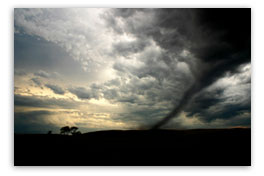Q&A with Cindy Chiu, PhD, MPH, researcher in the Centers for Disease Control and Prevention's National Center for Environmental Health
Cindy Chiu, an Epidemic Intelligence Service officer at the Centers for Disease Control and Prevention’s National Center for Environmental Health, studies the dangers that disasters pose to human health. A study she authored in APHA’s American Journal of Public Health looked at tornadoes that occurred in Alabama in 2011.
What findings from the study surprised you?
We were surprised to find that in a few households, some family members decided to seek shelter while others decided against it. Those who sought shelter survived, and those who did not died. It is important to take every warning seriously and to seek shelter immediately.
 We also saw that the majority of deaths indirectly related to the tornadoes were due to power outages. People often are not aware that injuries and deaths related to power outages can happen days after tornadoes. We recommend that people prepare for extended power outages by having a storm survival kit ready.
We also saw that the majority of deaths indirectly related to the tornadoes were due to power outages. People often are not aware that injuries and deaths related to power outages can happen days after tornadoes. We recommend that people prepare for extended power outages by having a storm survival kit ready.
Finally, we found that among those who received warnings, word-of-mouth warnings were the most common. We believe peer warnings can help disseminate warnings to people at risk — especially those in rural areas without sirens nearby — and motivate people to seek shelter.
Did your study shed light on any ways in which implementation of tornado safety has improved? What efforts might we need to improve on?
Our study found that many persons who were warned did take protective actions, many of which were in line with recommendations from CDC and the National Oceanic and Atmospheric Administration. This tells us our public health messaging is reaching people. However, due to the severity of these tornadoes, even locations historically considered safer did not guarantee survival.
Since this event, the Federal Emergency Management Agency has issued funds to build community storm shelters and individual reinforced safe rooms that are known to withstand EF-4 and EF-5 tornadoes. These efforts are encouraging, because having access to a safe shelter is critical to surviving severe tornadoes.
Based on your findings, what key recommendations do you have for staying safe in the event of a tornado?
We recommend that people have a personal or family preparedness plan that identifies a safe shelter ahead of time, prepares for power outages and plans to assist older adults and vulnerable family members. It is important to review and practice these plans, so they can be executed as soon as a warning is received.
In addition, every home should have a storm survival kit with flashlights, spare batteries, a battery-powered radio, a first-aid kit and enough water and non-perishable food for three days. Persons dependent on electric medical devices or refrigerated medications should have contingency plans ready.
We recommend that when people hear a warning, they should tell a friend. However, it is important to seek shelter before warning others.
For more information on how to stay safe during a tornado, visit CDC's website and check out Get Ready's tornado fact sheet.